Beechcraft Model 18
| Model 18 | |
|---|---|

| |
| Instructor and pilot in an AT-7 doing navigation training at Kelly Field, Texas. | |
| Role | Trainer and utility aircraft |
| National origin | United States |
| Manufacturer | Beech Aircraft Corporation |
| First flight | January 15, 1937 |
| Introduction | 1937 |
| Primary users | United States Army Air Forces United States Navy Royal Air Force Royal Canadian Air Force |
| Produced | 1937–1970 |
| Number built | 9,000+ |
The Beechcraft Model 18 (or "Twin Beech", as it is also known) is a six to 11-seat,[1] twin-engined, low-wing, tailwheel light aircraft manufactured by the Beech Aircraft Corporation of Wichita, Kansas. Continuously produced from 1937 to November 1969 (over 32 years, the world record at the time), over 9,000 were produced, making it one of the world's most widely used light aircraft. Sold worldwide as a civilian executive, utility, cargo aircraft, and passenger airliner on tailwheels, nosewheels, skis or floats, it was also used as a military aircraft.[2][3][4]
During and after World War II, over 4,500 Beech 18s saw military service—as light transport, light bomber (for China), aircrew trainer (for bombing, navigation and gunnery), photo-reconnaisance, and "mother ship" for target drones—including United States Army Air Forces (USAAF) C-45 Expeditor, AT-7 Navigator, AT-11 Kansan; and United States Navy (USN) UC-45J Navigator, SNB-1 Kansan, and others. In World War II, over 90% of USAAF bombardiers and navigators trained in these aircraft.[2][3][5]
In the early postwar era, the Beech 18 was the pre-eminent "business aircraft" and "feeder airliner." Besides carrying passengers, its civilian uses have included aerial spraying, sterile insect release, fish seeding, dry ice cloud seeding, aerial firefighting, air mail delivery, ambulance service, numerous movie productions, skydiving, freight, weapon- and drug-smuggling, engine testbed, skywriting, banner towing, and stunt aircraft. Many are now privately owned, around the world, with over 300 in the U.S. still on the FAA Aircraft Registry in December 2014.[2][4][6][7]
Design and development
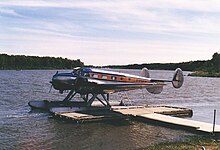
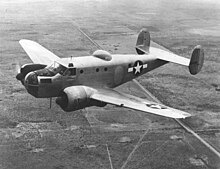

By the late 1930s, Beechcraft management speculated that a demand would exist for a new design dubbed the Model 18, which would have a military application, and increased the main production facilities. The design was mainly conventional for the time, including twin radial engines, all-metal semimonocoque construction with fabric-covered control surfaces and tailwheel undercarriage. Less conventional was the twin-tailfin configuration. The Model 18 can be mistaken for the larger Lockheed Electra series of airliners which closely resemble it. Early production aircraft were powered either by two 330-hp (250-kW) Jacobs L-6s or 350-hp (260-kW) Wright R-760Es. The 450-hp (336-kW) Pratt & Whitney R-985 became the definitive engine from the prewar C18S onwards. The Beech 18 prototype first flew on January 15, 1937.
Prior to the Pearl Harbor attack, the Beech 18 was outsold by the Lockheed 12 by two-to-one. However, war priorities forced Lockheed to concentrate on its heavier aircraft, and Beechcraft received a major boost through wartime contracts.[citation needed]
The aircraft has used a variety of engines and has had a number of airframe modifications to increase gross weight and speed. At least one aircraft was modified to a 600-hp (447-kW) Pratt & Whitney R-1340 powerplant configuration. With the added weight of about 200 lb (91 kg) per engine, the concept of a Model 18 fitted with R-1340 engines was deemed unsatisfactory due to the weakest structural area of the aircraft being the engine mounts. Nearly every airframe component has been modified.
In 1955, deliveries of the Model E18S commenced; the E18S featured a fuselage that was extended 6 in (150 mm) higher for more headroom in the passenger cabin. All later Beech 18s (sometimes called Super 18s) featured this taller fuselage, and some earlier models (including one AT-11) have been modified to this larger fuselage. The Model H18, introduced in 1963, featured optional tricycle undercarriage. Unusually, the undercarriage was developed for earlier-model aircraft under an STC by Volpar, and installed in H18s at the factory during manufacture. A total of 109 H18s were built with tricycle undercarriage, and another 240 earlier-model aircraft were modified with this.[8][9]
Construction of the Beechcraft Model 18 ended in 1970 with a final Model H18 going to Japan Airlines. Through the years, 32 variations of the basic design had flown, over 200 improvement modification kits were developed, and almost 8,000 aircraft were built. In one case, the aircraft was modified to a triple tail, trigear, humpbacked configuration and appeared similar to a miniature Lockheed Constellation. Another distinctive conversion was carried out by PacAero as the Tradewind. This featured a lengthened nose to accommodate the tricycle nosewheel, and the Model 18's twin tailfins were replaced by a single fin.[10]
Operational history
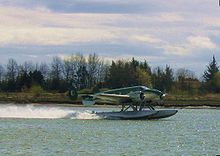
Production got an early boost when Nationalist China paid the company US$750,000 for six M18R light bombers,[11] but by the time of the U.S. entry into World War II, only 39 Model 18s had been sold, of which 29 were for civilian customers.[8][12] Work began in earnest on a variant specifically for training military pilots, bombardiers, and navigators. The effort resulted in the Army AT-7 and Navy SNB. Further development led to the AT-11 and SNB-2 navigation trainers and the C-45 military transport. The United States Air Force (USAF) Strategic Air Command had Model 18 variants (AT-11 Kansans, C-45 Expeditors, F-2 Expeditors (the "F" standing for "Fotorecon", short for "photographic reconnaissance"), and UC-45 Expeditors) from 1946 until 1951. From 1951 to 1955, the USAF had many of its aircraft remanufactured with new fuselages, wing center sections, and undercarriages to take advantage of the improvements to the civil models since the end of World War II. Eventually, 900 aircraft were remanufactured to be similar to the then-current Model D18S and given new designations, constructor's numbers and Air Force serial numbers.[13] The USN had many of its surviving aircraft remanufactured as well, these being redesignated as SNB-5s and SNB-5Ps.[citation needed] The C-45 flew in USAF service until 1963, the USN retired its last SNB in 1972, while the U.S. Army flew its C-45s until 1976. In later years, the military called these aircraft "bug smashers" in reference to their extensive use supplying mandatory flight hours for desk-bound aviators in the Pentagon.[14]
Beech 18s were used extensively by Air America during the Vietnam War; initially more-or-less standard ex-military C-45 examples were used, but then the airline had 12 aircraft modified by Conrad Conversions in 1963 and 1964 to increase performance and load-carrying capacity. The modified aircraft were known as Conrad Ten-Twos, as the maximum takeoff weight (MTOW) was increased to 10,200 lb (4,600 kg).[15][16] The increase was achieved by several airframe modifications, including increased horizontal stabilizer angle-of-incidence, redesigned undercarriage doors, and aerodynamically improved wingtips. Air America then had Volpar convert 14 aircraft to turboprop power, fitted with Garrett AiResearch TPE-331 engines; modified aircraft were called Volpar Turbo Beeches, and also had a further increase in MTOW to 10,286 lb (4,666 kg).[15]
Spar problems

The wing spar of the Model 18 was fabricated by welding an assembly of tubular steel. The configuration of the tubes in combination with drilled holes from aftermarket STC modifications on some of these aircraft have allowed the spar to become susceptible to corrosion and cracking while in service.[17] This prompted the FAA to issue an Airworthiness Directive in 1975, mandating the fitting of a spar strap to some Model 18s. This led, in turn, to the retirement of a large number of STC-modified Model 18s when owners determined the aircraft were worth less than the cost of the modifications. The corrosion on unmodified spars was not a problem, and occurred due to the additional exposed surface area created through the STC hole-drilling process. Further requirements have been mandated by the FAA and other national airworthiness authorities, including regular removal of the spar strap to allow the strap to be checked for cracks and corrosion and the spar to be X-rayed. In Australia, the airworthiness authority has placed a life limit on the airframe, beyond which aircraft are not allowed to fly.[18][19][20]
Variants
Manufacturer models
Unless otherwise noted, the engines fitted are Pratt & Whitney R-985 radials.
- Model 18A
- First production model with seating for two pilots and seven or eight passengers, fitted with Wright R-760E-2 engines of 350 horsepower (260 kW), MTOW: 6,700 lb (3,000 kg)[21][22]
- Model S18A
- Version of Model 18A capable of being fitted with skis or Edo 55-7170 floats; MTOW: 7,200 lb (3,300 kg)[22]
- Model 18B
- Improved model with increased range and useful load, fitted with 285 hp (213 kW) Jacobs L-5 engines[21][23][24]
- Model S18B
- Version of Model 18B capable of being fitted with skis or floats.
- Model 18D
- Variant with seating for two pilots and nine passengers, fitted with Jacobs L-6 engines of 330 horsepower (250 kW), MTOW: 7,200 lb (3,300 kg).[25]
- Model S18D
- Version of Model 18D capable of being fitted with skis or Edo 55-7170 floats, MTOW: 7,170 lb (3,250 kg)[12][25]
- Model A18D
- Variant of 18D with MTOW increased by 300 lb (140 kg) to 7,500 lb (3,400 kg), fitted with Pratt and Whitney R-985 engines with 450 hp each[25]
- Model SA18D
- Seaplane version of Model A18D, but same MTOW as S18D, fitted with Edo 55-7170 floats[25]
- Model A18A
- Version fitted with Pratt and Whitney R-985 engines of 450 horsepower (340 kW), MTOW: 7,500 lb (3,400 kg)[25]
- Model SA18A
- Seaplane version of Model A18A, fitted with Edo 55-7170 floats, MTOW: 7,170 lb (3,250 kg)[25]
- Model 18R
- Model with Pratt and Whitney R-985-A1 engines with dual-stage blower for increased power at higher operating altitudes, 450 horsepower (340 kW), seven built, one to Sweden as an air ambulance, six to Nationalist China as M18R light bombers[11][21]
- Model 18S
- Nine-passenger pre-World War II civil variant, served as basis for USAAF C-45C[1]
- Model B18S
- Nine-passenger pre-World War II civil variant, served as basis for USAAF F-2[1]
- Model C18S
- Variant of B18S with seating for eight passengers, and equipment and minor structural changes[26]
- Model D18S
- First post-World War II variant introduced in 1945, with seating for eight passengers and MTOW of 8,750 lb (3,970 kg), 1,035 built[27][28]
Two hundred and eighty D Models were made for the Royal Canadian Air Force (RCAF), given the service name 'Expeditor' and delivered between 1951 and 1952.[29] Seating for RCAF was for five passengers, or two RCAF Navigator students and one RCAF navigator instructor.[30] MTOW for RCAF was 9300 lbs.[31]
- 3N: Fitted as a navigation trainer with astrodome and two trainee stations in the cabin; 88 built[32]
- 3NM: Fitted primarily as a navigational trainer, and is fitted with floor lugs to accept transport seats on removal of navigation equipment; 59 built[33]
- 3NMT: Basically a 3NM, converted to a transport aircraft; 67 built[34]
- 3NMT(Special): Fitted as a navigation trainer personnel transport. First navigation training position retained, slightly modified ie: removal of air position indicator and replaced with radio compass and indicator from removed second navigation position; in addition, three reclining-type chairs fitted; 19 built[35]
- 3TM: Normally fitted with transport type seats, but has the necessary wiring, plumbing, and fittings for conversion to a navigation trainer, including provisions for fitting an astrodome; 44 built[32]
- 3TM(Special): Specifically modified RCAF Expeditor under Project WPB6, and refers specifically to overseas Expeditors; three built[36]
- Model D18C
- Variant with Continental R9-A engines of 525 horsepower (391 kW) and MTOW of 9,000 lb (4,100 kg), introduced in 1947, 31 built.[27][37]
- Model E18S
- Variant with redesigned wing and MTOW of 9,300 lb (4,200 kg); 403 built[27]
- Model E18S-9700
- Variant of E18S with MTOW of 9,700 lb (4,400 kg); 57 built[27]
- Model G18S
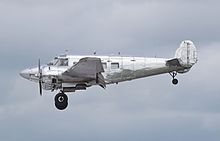
- Model H18
- Last production version, fitted with optional tricycle undercarriage developed by Volpar and MTOW of 9,900 lb (4,500 kg); 149 built, of which 109 were manufactured with tricycle undercarriage[8][27][28]
Military versions
- RC-45A
- Redesignation of all surviving F-2, F-2A, and F-2B aircraft by the USAF in 1948
- C-45B
- Based on C18S, but with modified internal layout; 223 ordered, redesignated UC-45B in 1943[26][39]
- Expeditor I: Some C-45Bs were supplied to the RAF under Lend-Lease.
- C-45C
- Two Model 18S aircraft impressed into the USAAF, redesignated UC-45C in January 1943[1][21][40]
- C-45D
- Designation given to two AT-7 aircraft converted as passenger transports during manufacture, redesignated UC-45D in January 1943[40][41]
- C-45E
- Designation given to two AT-7 and four AT-7B aircraft converted as passenger transports during manufacture, redesignated UC-45E in January 1943[40][41]
- C-45F
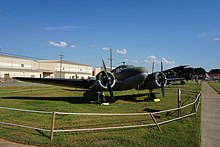
- Standardized seven-seat version based on C18S, with longer nose than preceding models;[26] 1,137 ordered, redesignated UC-45F[39]
- Expeditor II: C-45Fs supplied to the RAF and Royal Navy under Lend-Lease
- Expeditor III: C-45Fs supplied to the RCAF under Lend-Lease
- C-45G
- AT-7s and AT-11s remanufactured in the early 1950s for the USAF to similar standard as civil D18S with autopilot and R-985-AN-3 engines; 372 aircraft rebuilt[13][42]
- TC-45G
- Multiengine crew trainer variant of C-45G; AT-7s and AT-11s remanufactured in the early 1950s for the USAF to similar standard as civil D18S, 96 aircraft rebuilt[13][42]

- C-45H
- AT-7s and AT-11s remanufactured in the early 1950s for the USAF to similar standard as civil D18S, with no autopilot and R-985-AN-14B engines; 432 aircraft rebuilt[13][43]
- TC-45H [27]
- RC-45J [27]
- In 1962, all surviving U.S. Navy SNB-5Ps were redesignated RC-45J.
- TC-45J [27]
- In 1962 all surviving U.S. Navy SNB-5s were redesignated TC-45J.
- UC-45J [27]
- AT-7 Navigator
- Navigation trainer based on C18S,[26] with an astrodome and positions for three students, powered by 450-hp Pratt & Whitney R-985-25 engines; 577 built[38][39]
- AT-7A
- Floatplane version of AT-7; six built[38]
- AT-7B
- Winterised AT-7; nine built[38]
- AT-11 Kansan

- Bombing and gunnery trainer for USAAF derived from AT-7, fuselage had small, circular cabin windows, bombardier position in nose, and bomb bay; gunnery trainers were also fitted with two or three .30-caliber machine guns, early models (the first 150 built) had a single .30-cal AN-M2 in a Beechcraft-manufactured top turret, later models used a Crocker Wheeler twin .30-cal top turret, a bottom tunnel gun was used for tail gunner training, 1,582 built for USAAF orders, with 24 ordered by Netherlands repossessed by USAAF and used by the Royal Netherlands Military Flying School at Jackson, Mississippi.[44][45]
- AT-11A
- Conversion of AT-11 as navigation trainer; 36 converted[45]
- CQ-3
- Conversion of UC-45F, modified to act as drone control aircraft, redesignated as DC-45F in June 1948[citation needed]
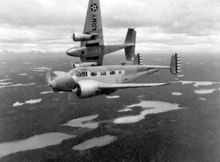
- F-2
- Photo-reconnaissance version based on B18[1]
- F-2A
- Improved version
- F-2B
- JRB-1
- Photographic aircraft for the U.S. Navy, based on the C18S,[26] fitted with fairing over cockpit for improved visibility, 11 built[46]
- JRB-3
- Photographic version, similar to C-45B; 23 built[46]
- JRB-4
- Utility transport version, equivalent to UC-45F'; 328 built.[46]
- JRB-6 [27]

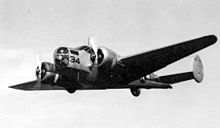
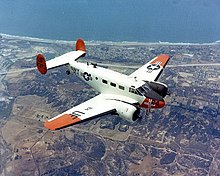
- SNB-2
- Navigation trainer for the U.S. Navy,[47] similar to AT-7, 299 built
- SNB-2C
- Variant for the U.S. Navy, similar to AT-7C[47]
- SNB-2H
- Ambulance conversion for the U.S. Navy[47]
- SNB-2P
- Photo-reconnaissance trainer for the U.S. Navy[47]
- SNB-3
- Variant for the U.S. Navy, similar to AT-7C
- SNB-3Q
- Electronic counter-measures trainer for the U.S. Navy
- SNB-5 [27]
- SNB-2s and SNB-2Cs were remanufactured, and designated SNB-5 by the U.S. Navy.
- SNB-5P [27]
- Photo-reconnaissance trainer for the U.S. Navy
Conversions
- PAC Super 18S Tradewind
- Custom conversion of Beech D-18S/C-45 to five- to 11-seat executive transport by Pacific Airmotive
- Hamilton HA-1
- conversion of a TC-45J aircraft
- Hamilton Little Liner
- Modification of D18S with aerodynamic improvements and new, retractable tailwheel, capable of carrying 11 seats[49]
- Hamilton Westwind
- Turboprop conversions with various engines
- Hamilton Westwind II STD
- Stretched conversion powered by two 840-hp PT6As, and with accommodation for up to 17 passengers.[50]
- Hamilton Westwind III
- two 579-hp PT6A-20s or 630-hp PT6A-27s or 630-hp Lycoming LTS101s.
- Hamilton Westwind IV
- two 570-hp Lycoming LTP101s or 680-hp PT6A-28s or 750-hp PT6A-34s or 1020-hp PT6A-45s
- Volpar (Beechcraft) Model 18
- Conversion of Model 18 with nosewheel undercarriage[51][52]
- Volpar (Beechcraft) Super 18
- Volpar (Beechcraft) Turbo 18
- Beech Model 18s fitted with the Volpar MkIV tricycle undercarriage and powered by two 705-hp Garrett TPE331-1-101B turboprop engines, flat-rated to 605 hp (451 kW), driving Hartzell HC-B3TN-5 three-bladed, reversible-pitch, constant-speed feathering propellers[52]
- Volpar (Beechcraft) Super Turbo 18
- 2x 705 hp (526 kW) Garrett TPE331
- Volpar (Beechcraft) C-45G
- C-45G aircraft modified with tricycle undercarriage
- Volpar (Beechcraft) Turboliner
- 15-passenger version of the Turbo 18 with extended fuselage, powered by 2 705-hp Garrett TPE331-1-101Bs[53]
- Volpar (Beechcraft) Turboliner II
- Turboliners modified to meet SFAR 23[53]
Operators
Civil
As of 2012[update], the Beechcraft Model 18 remains popular with air charter companies and small feeder airlines worldwide.
Military





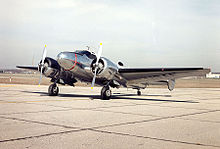
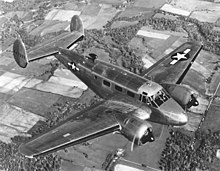
- Royal Canadian Air Force 394 examples from 1941–1972[57]
- Royal Canadian Navy 10 examples from 1952–1960[58]
 Honduras
Honduras
- Italian Air Force operated 125 aircraft from 1949 until the 1970s[64]
Aircraft on display
Argentina
- AT-11A 3495 - at the Museo Nacional de Aeronáutica de Argentina in Buenos Aires.[69]
- C-45H 5621 - at the Museo Nacional de Aeronáutica de Argentina in Buenos Aires.[70]
- C-45H AF-555 - at the Museo Nacional de Aeronáutica de Argentina in Buenos Aires.[71]
- H18S c/no. BA-752 (former LV-JFH) - at the Museo Nacional de Aeronáutica de Argentina in Buenos Aires.[72]
Australia
- E18S c/no. BA-81 (former N3781B) - at the Queensland Air Museum in Caloundra, Queensland.[73]
Belgium
- 3NM floatplane c/no CA-191 (former C-FGNR) - at Pairi Daiza.[74][better source needed]
Brazil
- AT-11 4615 - at the Museu Aeroespacial in Rio de Janeiro, Brazil.[75][76]
- C-45F 2856 - at the Museu Aeroespacial in Rio de Janeiro, Brazil.[77][78]
Canada
- C-45H 459 - at the Canadian Bushplane Heritage Centre in Sault Ste. Marie, Ontario. Tail code CF-MJY[79][80]
- 3TM 8034 - at the Canadian Bushplane Heritage Centre in Sault Ste. Marie, Ontario.[81]
- D18S c/no. A-141 (former CF-MPH)- at the RCMP Academy, Depot Division in Regina, Saskatchewan.[82]
- D18S c/no. A-142 (former CF-MPI) - at the Bomber Command Museum of Canada in Nanton, Alberta.[82][83]
- D18S c/no. A-156 - at the Canadian Warplane Heritage Museum in Hamilton, Ontario.[84]
- 3N c/no. A-652 (former RCAF 1477) - at the Royal Aviation Museum of Western Canada in Winnipeg, Manitoba.[82][85]
- 3NMT c/no. A-700 - at the Canadian Air Land Sea Museum at Toronto/Markham Airport in Markham, Ontario.[82]
- 3NM c/no. A-710 - at the North Atlantic Aviation Museum in Gander, Newfoundland and Labrador.[82][86]
- 3NMT c/no. A-782 (former CF-CKT) - at the Canadian Museum of Flight in Langley, British Columbia.[87][88]
- 3NMT c/no. A-872 - at the TransCanada Highway in Ignace, Ontario.[82][89]
- 3NM c/no. A-895 - at the Alberta Aviation Museum in Edmonton, Alberta.[82][90]
Chile
- D-18S c/no. A-1024 (former FACh 465) - at the Museo Aeronautico y del Espacio in Santiago, Chile.[91][92]
India
- D18S identity unknown - at the Hotel Mayfair Lagoon in Bhubaneswar, Orissa.[93]
Italy
- C-45F 6668 - suspended inside the Olbia Costa Smeralda Airport passenger terminal in Olbia, Sardinia.[94] This was the first aircraft owned by Alisarda Airlines and was used in the filming of the movie The Last Emperor.[95]
Malta
- C-45H 8304 - under restoration at the Malta Aviation Museum in Ta' Qali, Malta.[96][97]
Netherlands
- C-45G 51-11665 - at the Aviodrome in Lelystad, Netherlands.[98] This aircraft was used in the filming of the Bond movie Octopussy.[citation needed]
- D18S (former PH-UBX) - at entrance of Arnhem War Museum[citation needed]
New Zealand
- AT-11 3691 - at the Museum of Transport and Technology in Auckland, New Zealand.[99][better source needed]
Portugal
- AT-11 2504 - at the Museu do Ar in Sintra, Portugal.[94]
- AT-11 2508 - at a local park in Leiria, Portugal.[citation needed]
Spain
- C-45H AF-752 - at Fundación Infante de Orleans in Madrid, Spain.[100]
Turkey
- AT-11 Kansan 6390/9-930 - at Istanbul Aviation Museum.[101]
United Kingdom
- E18S c/no. BA-111 (former N575C) - at the National Museum of Flight in East Lothian, Scotland.[102][103]
United States
- AT-11 41‐27561 -at the National Museum of the USAF in Dayton, Ohio.[104][105] or 42-37493[94]
- AT-11B 41-27616 -at the Travis Air Force Base Heritage Center at Travis AFB, California.[94][106]
- AT-11 42-36887 - at the Barksdale Global Power Museum in Bossier City, Louisiana.[107]
- AT-11 42-37240 - at the Lone Star Flight Museum in Galveston, Texas.[108][109]
- UC-45 42-37496 - at the Wings Over the Rockies Air and Space Museum in Denver, Colorado. This aircraft was originally an AT-11 before being remanufactured.[110]
- UC-45F 44-47342 - at the Alaska Aviation Heritage Museum in Anchorage, Alaska.[111][112]
- TC-45H 51-11529 - at the Tri-State Warbird Museum in Batavia, Ohio.[113]
- C-45H 51-11696 - at the Museum of Flight in Seattle, Washington.[114]
- C-45G 51-11795 - at the Air Mobility Command Museum in Dover, Delaware.[115]
- C-45G 51-11897 - at the Castle Air Museum in Atwater, California.[116][117]
- C-45H 52-10539 - at the 1941 Historical Aircraft Group Museum in Geneseo, New York.[118][119]
- C-45H 52-10865 - at the Travis Air Force Base Heritage Center at Travis AFB, California.[120][121]
- C-45H 52-10893 - at the National Museum of the USAF in Dayton, Ohio.[122]
- UC-45J 23774 - at Laughlin AFB in Del Rio, Texas.[94]
- RC-45J 51233 - at the Tennessee Museum of Aviation in Sevierville, Tennessee.[123][124]
- UC-45J 51291 - at the Aerospace Museum of California in Sacramento, California.[125]
- UC-45J 51338 - at the Minnesota Air National Guard Museum in St. Paul, Minnesota.[126]
- S18D c/no. 178 - at the Beechcraft Heritage Museum in Tullahoma, Tennessee.[127]
- D18S c/no. A-935 - at the Beechcraft Heritage Museum at Tullahoma Regional Airport in Tullahoma, Tennessee.[127]
- C-45H AF-824 - at the Beechcraft Heritage Museum in Tullahoma, Tennessee.[127]
- E18S c/no. BA-453 - at the Beechcraft Heritage Museum in Tullahoma, Tennessee.[127]
- H18 c/no. BA-670 - at the Lone Star Flight Museum in Galveston, Texas.[128]
Notable appearances in media
Specifications (UC-45 Expeditor)

Data from Jane's Fighting Aircraft of World War II.[129]
General characteristics
- Crew: 2 pilots
- Capacity: 6 passengers
Performance
See also
Aircraft of comparable role, configuration, and era
- Airspeed Oxford
- Avro Anson
- Barkley-Grow T8P-1
- Cessna AT-17 Bobcat
- De Havilland Dove
- Evangel 4500
- Fairchild AT-21 Gunner
- Lockheed Model 10 Electra
- Lockheed Model 12 Electra Junior
- Siebel Si 204
Related lists
References
Notes
- ^ a b c d e "Beech B18 Series Type Certificate." Federal Aviation Administration. Retrieved: August 8, 2008.
- ^ a b c "Long Description: Beechcraft D18S Twin Beech." National Air and Space Museum of the Smithsonian Institution, Washington, D.C. Retrieved: December 17, 2014.
- ^ a b "Factsheets: Beech C-45H Expeditor." National Museum of the U.S. Air Force, Wright-Patterson Air Force Base, Dayton, Ohio. Retrieved: December 17, 2014.
- ^ a b "Twin Beech: The 1930's airplane that set Beech Aircraft Corporation on a course towards 50 years of success", in Flying Magazine, Feb. 1982, pp.26-30, Retrieved: Dec. 17, 2014 from Google Books.
- ^ "Factsheets: Beech AT-11 Kansan." National Museum of the U.S. Air Force, Wright-Patterson Air Force Base, Dayton, Ohio. Retrieved: December 17, 2014.
- ^ Bauschspies, James S. and William E. Simpson, "Research and Technology Program Perspectives for General Aviation and Commuter Aircraft", NASA Contract NASW-3554 for NASA, Sept. 1982, N83-17454#. Retrieved: Dec. 18, 2014. (In particular, see: Table 2.4 "COMMUTER CARGO FLEET IN 1981 - TOP TEN AIRCRAFT MODELS - NUMBER IN FLEET," which notes Beech 18 units are more than the next two aircraft combined (Convair 500/680 and Douglas DC-3), and more than the next three general aviation aircraft combined.
- ^ "Beech 18" search results, FAA Aircraft Registry. Federal Aviation Administration. Retrieved: December 17, 2014.
- ^ a b c "Model 18 Specifications." Beechcraft Heritage Museum. Retrieved: August 24, 2008.
- ^ Young, Shad. "The Beechcraft Model 18 & Volpar Tri-Gear – A Brief History". ascendant-online.net. Retrieved: August 8, 2008.
- ^ "Expeditor." Canadian Museum of Flight. Retrieved: August 13, 2012.
- ^ a b "Beechcraft page." Aerofiles. Retrieved: August 12, 2008.
- ^ a b "S18D." Beechcraft Heritage Museum. Retrieved: August 12, 2008.
- ^ a b c d "C-45H." Beechcraft Heritage Museum. Retrieved: August 24, 2008.
- ^ O'Rourke, G.G, CAPT USN. "Of Hosenoses, Stoofs, and Lefthanded Spads." United States Naval Institute Proceedings, July 1968.
- ^ a b "Air America: Beech/Volpar Turbo Beech 18". University of Texas at Dallas, 2006. Retrieved: August 12, 2008.
- ^ Deakin, John. "Pelican's Perch #75:Those Dreadful POHs (Part 1)". AVweb, November 9, 2003. Retrieved: August 12, 2008.
- ^ Ramey, Taigh. "Spar concerns." Twinbeech.com. Retrieved: December 17, 2014.
- ^ Ramey, Taigh. "Vintage Aircraft: Things to Consider when Buying a Twin Beech Project." Twinbeech.com, Stockton, California. Retrieved: August 24, 2008.
- ^ "FAA Airworthiness Directive No. AD 75-27-09. Federal Aviation Administration. Retrieved: August 24, 2008
- ^ "CASA Airworthiness Directive No. AD/BEECH 18/17." CASA. Retrieved: August 24, 2008.
- ^ a b c d "USA Warplanes C-45 page." uswarplanes.net. Retrieved 24 August 2008.
- ^ a b "Beech 18A Series Type Certificate." Federal Aviation Administration. Retrieved: August 9, 2008.
- ^ "Beech 18 (C-45F)." AircraftWorldDirectory.com. Retrieved 28 August 2008.
- ^ McKillop, Jack. "Beech JRB Expedition (sic), Beech SNB Kansan and Navigator". microworks.ne. Retrieved: August 28, 2008.
- ^ a b c d e f "Beech 18D/A18 Series Type Certificate." Federal Aviation Administration.Retrieved: August 8, 2008.
- ^ a b c d e f g h i "Beech C18S Type Certificate." Federal Aviation Administration. Retrieved: August 12, 2008.
- ^ a b c d e f g h i j k l m n FAA Beech D18/E18/G18/H18 Series Type Certificate.. Retrieved 8 August 2008.
- ^ a b c d "Aircraft Serial Number Lists 1945–2008." Hawker Beechcraft. Retrieved: August 8, 2008.
- ^ "RCAF Data Record Cards 1426 CA-1 to 1594 CA-280"". RCAF.
- ^ "Aircraft Operating Instructions Expeditor." RCAF, September 12, 1966, pp. 1–2, 1–4.
- ^ "Description and Maintenance Instructions Expeditor 3." RCAF, September 12, 1967, pp. 1–5.
- ^ a b "FAA Type Certificate A-765 (Beech D18/E18/G18/H18 Series)." Federal Aviation Administration, p. 48.
- ^ For the particular breakdown of each model for the RCAF, Refer to RCAF Data Record Cards CA-1 to CA-280.
- ^ "EO 05-45B-6A/130." RCAF, March 10, 1959.
- ^ "EO 05-45B-2 Description and Maintenance Instructions Expeditor 3." RCAF', September 12, 1967, p. I-1.
- ^ "EO 05-45B-1 Aircraft Operating Instructions." RCAF, September 26, 1966, Supplement B, p. 2.
- ^ "Beech 18". Airliners.net. Retrieved: August 8, 2008.
- ^ a b c d e f Donald 1995, p. 7.
- ^ a b c d Swanborough and Bowers 1963, p. 36.
- ^ a b c Baugher, Joe. "USAAF 1942 Serial Number List." USAAS-USAAC-USAAF-USAF Aircraft Serial Numbers–1908 to Present. Retrieved: June 11, 2011.
- ^ a b Baugher, Joe. "USAAF 1943 Serial Number List." USAAS-USAAC-USAAF-USAF Aircraft Serial Numbers–1908 to Present. Retrieved: June 11, 2011.
- ^ a b Baugher, Joe. "USAF 1951 Serial Number List." USAAS-USAAC-USAAF-USAF Aircraft Serial Numbers–1908 to Present. Retrieved 11 June 2011.
- ^ Baugher, Joe. "USAF 1952 Serial Number List." USAAS-USAAC-USAAF-USAF Aircraft Serial Numbers–1908 to Present. Retrieved: August 24, 2008.
- ^ Donald 1995, pp. 7–8.
- ^ a b Swanborough and Bowers 1963, p. 37.
- ^ Taylor 1965, p. 280.
- ^ Taylor 1976, p. 300.
- ^ Taylor 1965, p. 316.
- ^ a b Taylor 1982, p. 483.
- ^ a b Taylor 1982, p. 484.
- ^ a b Bridgman 1951, p. 3a.
- ^ "AVIONES DE TRANSPORTE DE LA AVIACION NAVAL - "BEECHCRAFT AT11"". Histarmar - Historia y Arqueologia Marítima (in Spanish). Fundación Histarmar. Retrieved 2 May 2015.
- ^ a b Bridgman 1951, p. 4a.
- ^ Griffin 1969, pp. 5–6.
- ^ Pettipas 1986, pp. 42–43.
- ^ Bridgman 1951, p. 6a.
- ^ Bridgman 1951, p. 7a.
- ^ Bridgman 1951, p. 17a.
- ^ a b Bridgman 1951, p. 11a.
- ^ Bridgman 1951, p. 12a.
- ^ "Italian Air Force." aeroflight. Retrieved: December 17, 2014.
- ^ Bridgman 1951, p. 14a.
- ^ a b Bridgman 1951, p. 16a.
- ^ Bridgman 1951, p. 19a.
- ^ a b Bridgman 1951, p. 20a.
- ^ "Airframe Dossier - Beech AT-11A Kansan, s/n E-110 FAA, c/n 3495". Aerial Visuals. AerialVisuals.ca. Retrieved 30 March 2016.
- ^ "Airframe Dossier - Beech C-45H Expeditor, s/n 52-10629 USAF, c/n 5621, c/r LV-WEX {1}". Aerial Visuals. AerialVisuals.ca. Retrieved 30 March 2016.
- ^ "Airframe Dossier - Beech C-45H Expeditor, s/n A-216 ANdU, c/n AF-555, c/r LV-WEX {2}". Aerial Visuals. AerialVisuals.ca. Retrieved 30 March 2016.
- ^ "Airframe Dossier - Beech H18S, c/n BA-752, c/r LV-JFH". Aerial Visuals. AerialVisuals.ca. Retrieved 30 March 2016.
- ^ "BEECH E18S N3781B C/N BA-81)". Queensland Air Museum Inc. Retrieved 16 October 2016.
- ^ "Rallye, Tomahawk en Beech 18 in Pairi Daiza" [Rallye, Tomahawk and Beech 18 in Pairi Daiza]. luchtvaarterfgoed.be (in Dutch). 3 March 2014. Retrieved 16 October 2016.
- ^ "KANSAN - BEECHCRAFT AT-11 - BEECH AIRCRAFT CORPORATION". Museu Aerospacial. Retrieved 30 March 2016.
- ^ "Airframe Dossier - Beech 18, s/n 1371 FABr, c/n 4615". Aerial Visuals. AerialVisuals.ca. Retrieved 30 March 2016.
- ^ "EXECUTIVE - BEECHCRAFT D18S (C-45) - BEECH AIRCRAFT CORPORATION". Museu Aeroespacial. Retrieved 30 March 2016.
- ^ "Airframe Dossier - Beech UC-45F Expeditor, s/n 2856 FABr, c/n 2856". Aerial Visuals. AerialVisuals.ca. Retrieved 30 March 2016.
- ^ "Beech C-45 CF-MJY". Canadian Bushplane Heritage Centre. Canadian Bushplane Heritage Centre. Retrieved 30 March 2016.
- ^ "Airframe Dossier - Beech C-45H Expeditor, s/n 52-10632 USAF, c/n 459, c/r CF-MJY". Aerial Visuals. AerialVisuals.ca. Retrieved 30 March 2016.
- ^ "Airframe Dossier - Beech Expeditor 3TM, s/n 1421 RCAF, c/n 8034, c/r C-FUWE". Aerial Visuals. AerialVisuals.ca. Retrieved 30 March 2016.
- ^ a b c d e f g Goodall, Geoff. "PART 2: BEECH D18S/ D18C & RCAF EXPEDITER Mk.3" (PDF). Geoff Goodall's Aviation History Site. Geoffrey Goodall. Retrieved 30 March 2016.
- ^ "Beechcraft-18 Expeditor". Bomber Command Museum of Canada. Retrieved 21 March 2016.
- ^ "BEECHCRAFT EXPEDITOR". Canadian Warplane Heritage Museum. Canadian Warplane Heritage Museum. Retrieved 7 July 2015.
- ^ "Beech Expeditor, RCAF 1477". Royal Aviation Museum of Western Canada. Royal Aviation Museum of Western Canada. Retrieved 30 March 2016.
- ^ "Beechcraft 18-s". North Atlantic Aviation Museum. North Atlantic Aviation Museum. Retrieved 7 July 2015.
- ^ "Beechcraft 3NMT Expeditor". The Canadian Museum of Flight. Canadian Museum of Flight. Retrieved 7 July 2015.
- ^ "Airframe Dossier - Beech Expeditor 3NMT, s/n 2307 RCAF, c/n A-0782, c/r CF-CKT". Aerial Visuals. AerialVisuals.ca. Retrieved 30 March 2016.
- ^ Leeuw, Ruud. "Bushplanes at Ignace, Ontario". RuudLeeuw.com. Retrieved 30 March 2016.
- ^ "Beech D18S-3NM Expeditor (1952)". Alberta Aviation Museum. Retrieved 7 July 2015.
- ^ "BEECHCRAFT D-18S". Museo Nacional Aeronáutico y del Espacio. Archived from the original on 7 July 2015. Retrieved 30 March 2016.
- ^ "Aerial Visuals - Airframe Dossier - Beech D18S, s/n 465 FACh, c/n A-1024". Aerial Visuals. AerialVisuals.ca. Retrieved 30 March 2016.
- ^ "Beech 18 in Bhubaneswar". Warbirds of India. Warbirds of India. Retrieved 31 March 2016.
- ^ a b c d e Goodall, Geoff. "PREWAR CIVIL BEECH 18 PRODUCTION and CIVILIANISED WWII MILITARY PRODUCTION ( AT-7/ AT-11 / C-45 / SNB- / JRB- / Expediter )" (PDF). Geoff Goodall's Aviation History Site. Geoffrey Goodall. Retrieved 31 March 2016.
- ^ "I-SARE Project - Flying Again". YouTube. Retrieved 31 March 2016.
- ^ "Beechcraft 18S N495F". Malta Aviation Museum. Malta Aviation Museum Foundation. Retrieved 30 March 2016.
- ^ "Airframe Dossier - Beech C-45H Expeditor, s/n 52-10958 USAAF, c/n 8304, c/r N495F". Aerial Visuals. AerialVisuals.ca. Retrieved 30 March 2016.
- ^ "Airframe Dossier - Beech C-45G Expeditor, s/n 51-11665 USAAF, c/n AF-222, c/r G-BKRG". Aerial Visuals. AerialVisuals.ca. Retrieved 31 March 2016.
- ^ Wesley, Richard. "Beechcraft AT-11 Kansan". MOTAT Aircraft Collection. Blogger. Retrieved 31 March 2016.
- ^ "Beechcraft C-45". Fundación Infante de Orleans (in Spanish). Retrieved 31 March 2016.
- ^ "Hava Kuvvetleri Muzesi Komutanligi (Turkish Air Force Museum) - Yesilkoy - Istanbul - Turkey". aviationmuseum.eu. Retrieved 28 May 2016.
- ^ "Beech E-18S". National Museums Scotland. National Museums Scotland. Retrieved 30 March 2016.
- ^ "Airframe Dossier - Beech E18S, c/n BA-111, c/r N575C". Aerial Visuals. AerialVisuals.ca. Retrieved 30 March 2016.
- ^ "Beech AT-11 Kansan". National Museum of the US Air Force. Retrieved 30 March 2016.
- ^ "AIRCRAFT, DRONES AND MISSILES AT THE NATIONAL MUSEUM OF THE U.S. AIR FORCE" (PDF). National Museum of the US Air Force. Retrieved 31 March 2016.
- ^ "Outdoor Exhibits - AT-11 "Kansan"". Travis Heritage Center. Travis Heritage Center. Retrieved 30 March 2016.
- ^ "Aerial Visuals - Airframe Dossier - Beech AT-11 Kansan, s/n 42-36887 USAAF, c/n 3267, c/r N3983C". Aerial Visuals. AerialVisuals.ca. Retrieved 9 April 2016.
- ^ "Aircraft Status". Lone Star Flight Museum. Archived from the original on 5 November 2014. Retrieved 31 March 2016.
- ^ "Airframe Dossier - Beech AT-11 Kansan, s/n 42-37240 USAAF, c/r N81Y". Aerial Visuals. AerialVisuals.ca. Retrieved 31 March 2016.
- ^ "1943 UC-45 Expeditor". Wings Over the Rockies Air & Space Museum. Wings Over the Rockies Air & Space Museum. Retrieved 30 March 2016.
- ^ "1944 Beechcraft 18S S/N 7728 AFSN 44-4734 N1047B". Alaska Aviation Museum. Retrieved 30 March 2016.
- ^ "Airframe Dossier - Beech UC-45F Expeditor, s/n 44-47342 USAAF, c/n 7728, c/r N1047B". Aerial Visuals. AerialVisuals.ca. Retrieved 30 March 2016.
- ^ "FAA REGISTRY". Federal Aviation Administration. U.S. Department of Transportation. Retrieved 7 July 2015.
- ^ "Beech C-45H Expeditor". The Museum of Flight. The Museum of Flight. Retrieved 30 March 2016.
- ^ "C-45G Expeditor". Air Mobility Command Museum. AMC Museum Foundation, Inc. Retrieved 30 March 2016.
- ^ "Beech Aircraft Company C-45G Expeditor (USA)". Castle Air Museum. Castle Air Museum Foundation, Inc. Archived from the original on 6 January 2013. Retrieved 30 March 2016.
- ^ "Airframe Dossier - Beech RC-45H Expeditor, s/n 51-11897 USAF, c/n 4340, c/r N87681". Aerial Visuals. AerialVisuals.ca. Retrieved 30 March 2016.
- ^ "C-45H". National Warplane Museum. National Warplane Museum. Retrieved 30 March 2016.
- ^ "Airframe Dossier - Beech C-45H Expeditor, s/n 52-10539 USAF, c/n AF-469, c/r N45GC". Aerial Visuals. AerialVisuals.ca. Retrieved 30 March 2016.
- ^ "Outdoor Exhibits - C-45H "Expeditor"". Travis Heritage Center. Travis Heritage Center. Retrieved 30 March 2016.
- ^ "Airframe Dossier - Beech 18, s/n 52-10865 USAF". Aerial Visuals. AerialVisuals.ca. Retrieved 30 March 2016.
- ^ "Beech C-45H Expeditor". National Museum of the US Air Force. Retrieved 30 March 2016.
- ^ "Beechcraft SNB Specifications". Tennessee Museum of Aviation. Archived from the original on 8 July 2015. Retrieved 31 March 2016.
- ^ "Airframe Dossier - Beech RC-45J Expeditor, s/n 51233 USN, c/n 5560, c/r N145J". Aerial Visuals. AerialVisuals.ca. Retrieved 31 March 2016.
- ^ "Beech UC-45J Expediter". Aerospace Museum of California. Aerospace Museum of California. Retrieved 30 March 2016.
- ^ "BEECHCRAFT C-45 "EXPEDITOR"". Minnesota Air National Guard Museum. Minnesota Air National Guard Museum. Retrieved 30 March 2016.
- ^ a b c d "Unique & Rare Artifacts". Beechcraft Heritage Museum. Beechcraft Heritage Museum. Retrieved 30 March 2016.
- ^ "Airframe Dossier - Beech H18, c/n BA-670, c/r N954". Aerial Visuals. AerialVisuals.ca. Retrieved 31 March 2016.
- ^ Bridgeman 1946, p. 205.
Bibliography
- Bridgeman, Leonard, ed. “The Beechcraft Expeditor.” Jane's Fighting Aircraft of World War II. London: Studio, 1946. ISBN 1-85170-493-0.
- Bridgeman, Leonard. Jane's All The World's Aircraft 1951–52. London: Samson Low, Marston & Company, Ltd., 1951.
- Donald, David, ed.American Warplanes of World War II. London: Aerospace, 1995. ISBN 1-874023-72-7.
- Griffin, John A. Canadian Military Aircraft Serials & Photographs 1920 - 1968. Ottawa: Queen's Printer, Publication No. 69-2, 1969.
- Mondey, David. American Aircraft of World War II (Hamlyn Concise Guide). London: Bounty Books, 2006. ISBN 978-0-7537-1461-4.
- Ogden, Bob. Aviation Museums and Collections of North America. Tonbridge, Kent, UK: Air-Britain (Historians) Ltd., 2007. ISBN 0-85130-385-4.
- Pettipas, Leo. Canadian Naval Aviation 1945-1968. L. Pettipas/Canadian Naval Air Group, Winnipeg: 1986. ISBN 0-9692528-0-3
- Swanborough, F. Gordon and Peter M. Bowers. United States Military Aircraft since 1909. London: Putnam, 1963.
- Swanborough, Gordon and Peter M. Bowers. United States Navy Aircraft since 1911. London: Putnam, 1976. ISBN 0-370-10054-9.
- Taylor, John W. R. Jane's All The World's Aircraft 1965–66. London: Sampson Low, Marston & Company, 1965.
- Taylor, John W. R. Jane's All The World's Aircraft 1976–77. London: Jane's Yearbooks, 1976. ISBN 0-354-00538-3.
- Taylor, John W. R. Jane's All the World's Aircraft 1982-83. London: Jane's Publishing Company, 1982. ISBN 0-7106-0748-2.
- United States Air Force Museum Guidebook. Wright-Patterson AFB, Ohio: Air Force Museum Foundation, 1975.
